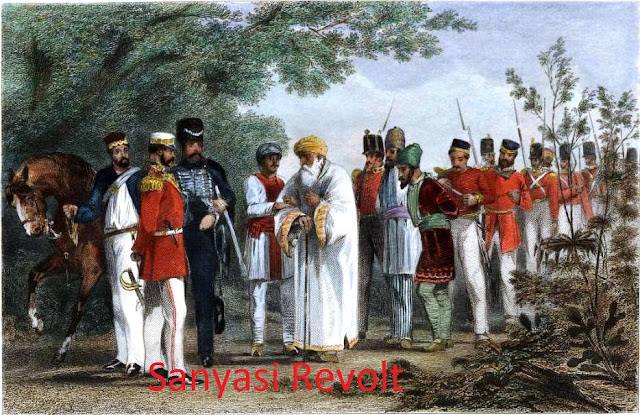The Sanyasi Revolt
The Sanyasi Revolt was a combine armed rebellion of both Muslim fakirs and Hindu Sannyasis. It was directed against the dominance of the English East India Company in Bengal. It took place around Murshidabad and Baikunthupur forests of Jalpaiguri. This resistance began in 1760 and continued for more than four decades.
We find the mention of Sanyasi revolt in the famous novels the Anandmath and the Debi Chaudurani written by Bankim Chandra Chattapadhyay. Poems of Majnu written by Panchanam Das and Rhym of Mahasthangarh written by Dwija Gaurikanta also give information about the Sanyasi Revolt. The famous leaders of this rebellion were Bhabani Pathak, Debi Choudhurani, Musha Shah, Majnu Shah and Paragal shah.
The leaders of the Sanyasi revolt were religious minded, but it was not a religious revolt. It was purely a peasant revolts. Many hungry peasants, landless zamindars and jobless army were united under the Sanyasis and the Fakirs. Attacking the kuthi, treasury, Granary and godowns of company was the main characteristics of the revolt. The leaders introduced guerilla tactics of warfare against the British. Internal conflict among the leaders was the main cause for its failure. Lack of fire arm, organization, and planning was also a cause of decline.
Causes of the Sanyasi Revolt
A Sanyasi or Fakir is a person who has renounced the world and is free from all attachments and worldly desires. The rebel Sanyasis and Fakirs were not necessarily men who had renounced the world. In fact, many were settled farmers. They used to go for their annual pilgrimage at a particular time of the year. The British were wary of these wandering men and called them by various epithets like ‘erratic beggars’, ‘gypsies of Hindusthan’, ‘lawless mendicants’, ‘religious vagrants’, etc.
After the establishment, the East India Company had imposed huge tax of the Zamindars of Bengal. Many zamindars had fallen upon hard times owing to the steep tax rates. It was the practice of the Sanyasis to collect alms and contributions from these zamindars during their religious travels. Paying a high revenue rate to the British, these zamindars found it too difficult to provide alms to Sanyasis and Fakirs.
The Sanyasi and Fakirs became resentful when the British administration intentionally imposed pilgrim taxes on them. During the famine of Bengal 1770, the rebels lost their confidence on the British and moneylenders. The Sanyasis rose in rebellion against the British and raided English factories and government treasuries.
Majnu Shah was an important leader. He travelled from places to places to inspire to continue struggle. After his death, his brother Musa Shah took the leadership and continued rebel for some time. Later, Chirag Shah led the Fakirs to launch attack on British establishments.
Bhabani Pathak was an important leader of the Sanyasi Movement in West Bengal. He was a large following in the downtrodden society and was acceptable much like Robinhood. He was killed by the British. Devi Chowdhurani led the Sanyasis after the death of Bhabani Pathak.
Important Question
Q1: Was Sanyasi simply a religious revolt?
Q2: Why the Sanyasi revolt failed?
Q3: Who were the leaders of Sanyasi revolt?
Q4: Where did the Sanyasi revolt? Write the names of its two leaders?
Q5: Write a short note on Sanyasi revolt.
Q6: What do you understand by the term Sanyasi?

Post a Comment